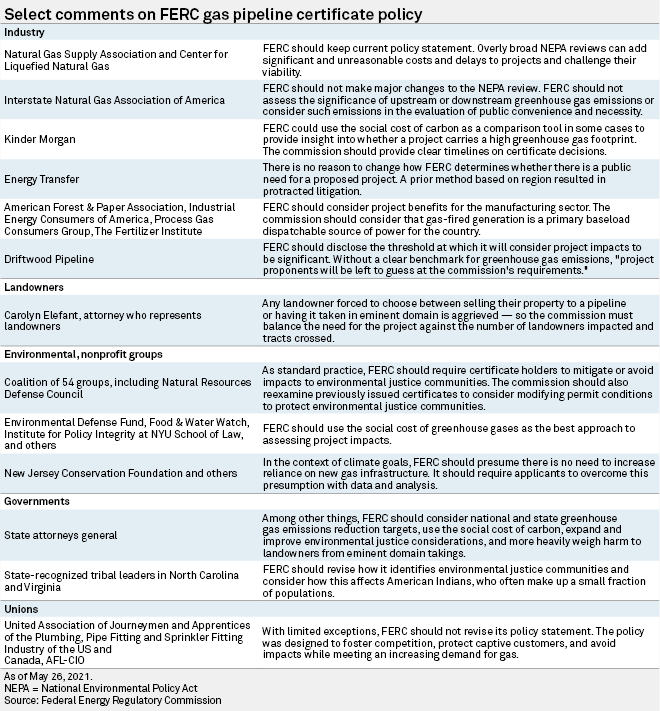S&P Global Offerings
Featured Topics
Featured Products
Events
S&P Global Offerings
Featured Topics
Featured Products
Events
S&P Global Offerings
Featured Topics
Featured Products
Events
Banking & Capital Markets
Economy & Finance
Energy Transition & Sustainability
Technology & Innovation
Podcasts & Newsletters
Banking & Capital Markets
Economy & Finance
Energy Transition & Sustainability
Technology & Innovation
Podcasts & Newsletters
S&P Global Offerings
Featured Topics
Featured Products
Events
27 May, 2021
By Corey Paul and Maya Weber
The U.S. Environmental Protection Agency staked out a new position on federal reviews of interstate natural gas pipelines, advising the Federal Energy Regulatory Commission to weigh the potential for "carbon lock-in" and the "costly irreversibility" of building such infrastructure.
The EPA, as a representative of the Biden administration, has the potential to shake up debate on a key FERC policy. The recommendation for a broad expansion of climate considerations would mark a sharp departure from the commission's historical approach. The EPA comment was a major one among a flood of filings from energy companies, environmental nonprofits, and others responding to the commission's updated notice of inquiry on how it might alter its 1999 natural gas pipeline certificate policy (PL18-1).
Gas pipeline companies and their allies argued that FERC's existing pipeline policy framework under the Natural Gas Act is sufficient. "The commission should be reticent to implement significant changes to a process that is working as Congress intended," the Interstate Natural Gas Association of America, or INGAA, told the regulator.
The EPA letter, signed by Associate Administrator Victoria Arroyo, echoed a sentiment of environmental groups that FERC should be careful about locking in long-lived infrastructure that releases greenhouse gas emissions or creates the potential for stranded assets. The environmental agency backed the idea that FERC could seek mitigation of a project's climate and environmental justice impacts, and offered possible options, such as considering compressor stations with electric turbines.
The EPA also recommended that FERC prioritize climate adaptation and resilience concerns, potentially helping avoid investments in locations that are vulnerable to the effects of climate change. The agency said FERC should "consider requiring applicants to incorporate climate-resilient design considerations and develop climate adaptation plans."
And in assessing whether a gas pipeline project is needed, FERC should examine whether other types of energy infrastructure could meet future energy demand, the EPA said.
Along with the Council on Environmental Quality, the EPA encouraged FERC to consider the climate impacts of upstream production and downstream end-use emissions. The EPA said FERC could deny a pipeline on grounds that the total impacts from upstream, downstream and direct activities would be too harmful to the environment. It suggested that FERC routinely include a quantitative estimate of downstream emissions.
Both the EPA and the CEQ suggested that the social cost of greenhouse gases could be a useful metric in pipeline reviews. The social cost of carbon is an estimate in dollars of the long-term economic damage caused by emissions for use in cost-benefit analyses.
Most pipelines and other energy companies took a more constrained view of the scope of FERC's legal authority to examine indirect emissions or require mitigation. INGAA argued that the commission should not rely on the social cost of carbon tool in certificate proceedings because it "is an expansive tool that incorporates factors beyond the authority of the commission to consider" under the Natural Gas Act. The group supported a previous finding by FERC that the tool is also "inadequately accurate" to use in reviews under the National Environmental Policy Act.

This view was not universal in the pipeline industry. Kinder Morgan Inc. said the social cost could be useful in some cases as a "screening tool" in an environmental impact statement. The tool could help FERC gauge whether emissions associated with a project are "uncharacteristically high" and compare projects against alternatives, the company said. But Kinder Morgan said it would be inappropriate to use the social cost of carbon for quantifying project benefits and impacts or for determining mitigation measures.
Environmental justice also got ample attention in the comments landing at FERC. The EPA has defined environmental justice communities as low-income or minority communities that have historically borne the brunt of impacts from industrial development.
A coalition of conservation groups led by the Natural Resources Defense Council said FERC should look back at prior certificate orders to see whether existing conditions adequately protect environmental justice communities, and it should weigh possible changes to these conditions. FERC should make it a regular practice to require certificate holders to mitigate or avoid impacts to environmental justice communities, the groups said.
INGAA urged FERC to set clear, consistent standards for identifying and promoting engagement with environmental justice communities. It said clearer definitions could help pipeline developers avoid such communities at the planning stage. The pipeline trade group said applicants should be able to propose alternatives or minimize impacts if disproportionate impacts were identified. But FERC should not push pipeline companies to mitigate for past environmental justice impacts associated with industrial impacts unrelated to the gas projects, INGAA said.
Other industry groups emphasized that FERC should consider any positive economic effects of gas projects for low-income communities in addition to negative impacts.
The EPA recommended that when FERC identifies disproportionate impacts on environmental justice communities, the commission considers developing a new alternative, modifying the project design, or including mitigation.
The EPA's recommendations followed sweeping executive orders signed by President Joe Biden that called for a "whole of government" approach to tackling climate change. Biden also reestablished an interagency working group to calculate the social cost of carbon. FERC was exempt from the orders as an independent agency.
"Ultimately, FERC is an economic regulator — not an environmental regulator — and these [climate] functions are more appropriately considered under the jurisdiction of CEQ and the EPA," the Natural Gas Supply Association wrote.
Maya Weber is a reporter for S&P Global Platts. S&P Global Market Intelligence and S&P Global Platts are owned by S&P Global Inc.
